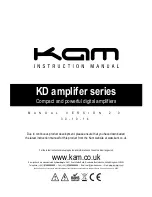
13
Input to Output Signal Flow
The amplifier's Flex Channels ‒ configurable in Q-SYS Designer Software (QDS) as mic/line inputs or line outputs ‒ are not physically
or electrically connected in the amplifier, giving you the flexibility to use any available source in Q-SYS for the amplified outputs and
to route the inputs to any output. The following diagram shows where gain, muting, and limiting are applied within the input to output
signal flow, as well as the QDS components used to configure parameters.
1. The analog inputs are converted to digital audio in the amplifier. The converted audio is then routed to the Q-SYS Core via Q-LAN
(LAN A).
2. The digital signals are brought into the design via the amplifier's Flex Input component. From the Flex Input component, the signals
can be sent for processing and can be sent anywhere within the Q-SYS system.
3. In the Q-SYS Core processor, digital audio signals (not necessarily from the amp's inputs) are sent to the Amp Output component.
4. The digital audio is then sent from the Q-SYS Core processor via Q-LAN to the amplifier.
5. Digital signals are converted to analog, amplified, and sent to outputs of the amplifier.
Loudspeaker
Configuration
Amp Protection
Limiters
DAC
Limiter Feedback Loop
Amp
Gain
3
Amp Output
Configuration
Q-SYS Core DSP
ADC
Digital Gain
2
Analog Gain
1
Output Limiter
Signal (-50 dBFS+ detected)
3. -100 to +20 dB
Input Mute
Peak Limiter
Threshold = User Controlled
Attack Time = User Controlled
Release Time = User Controlled
RMS Limiter
Threshold = User Controlled
Attack = User Controlled
Release = User Controlled
Delay
(0-2 Sec)
Gain
Gain (-100 to +20dB)
Mute
Custom Voicing
(Where Applicable)
Band Pass Gain(-100-+20dB)
Mute
Invert
Driver Delay (0-5ms)
Filterset
Within Speaker Component
Within Amplifier
Channel Mute
Within Amplifier
1. Up to +51dB
2. Up to +20dB
Front Panel LEDs
Flex In
Component
Analog Input
Flex In
Component
Speaker
Component
Amp Output
Component

































